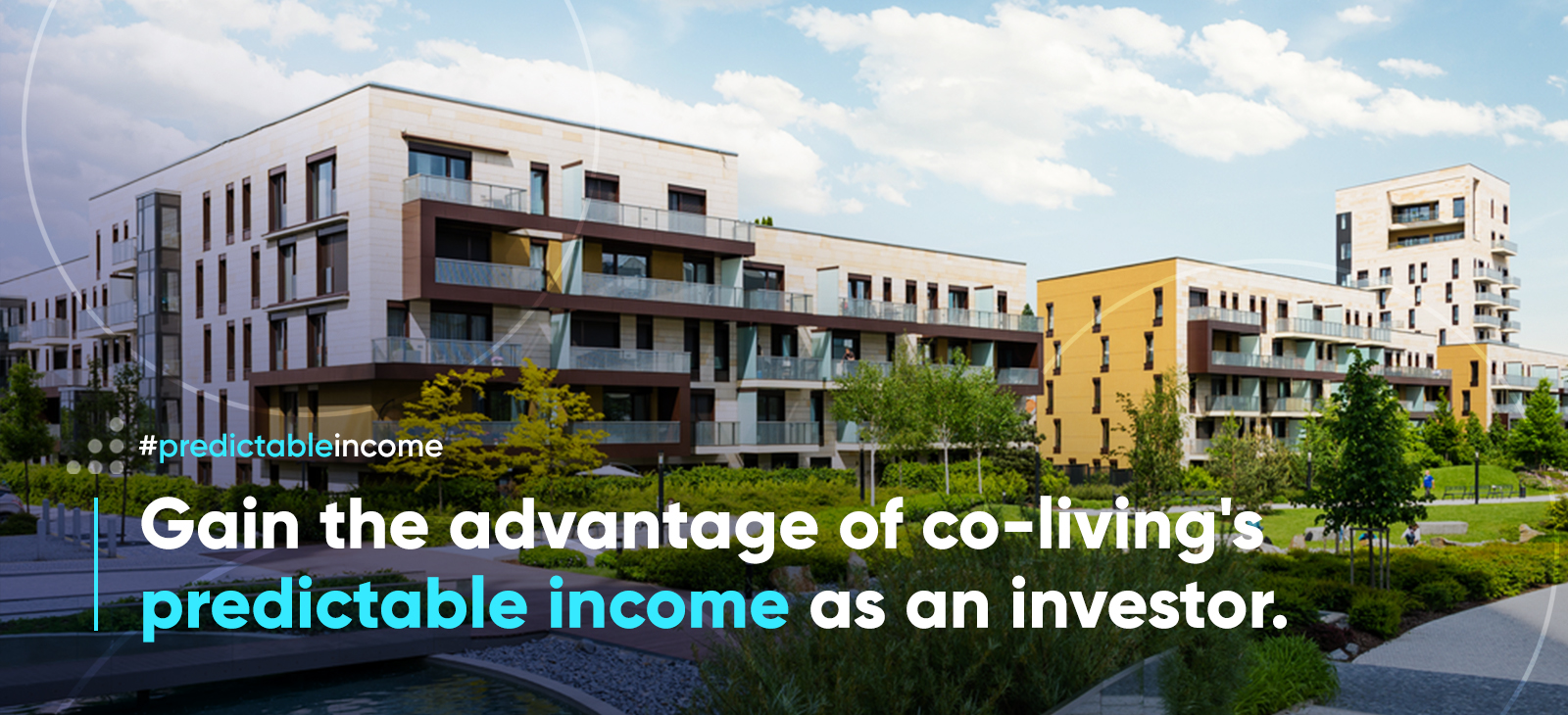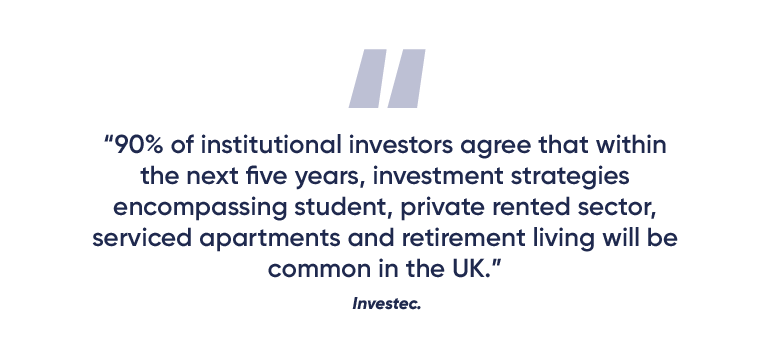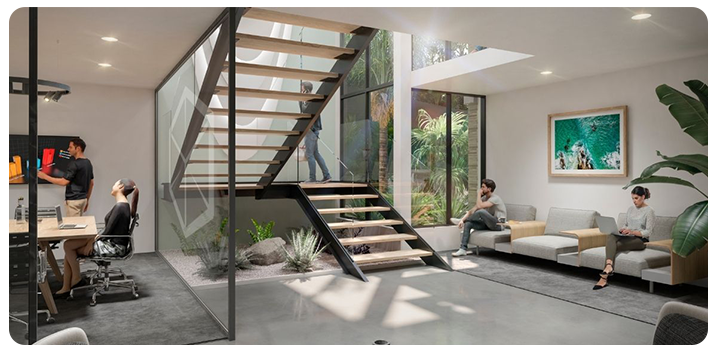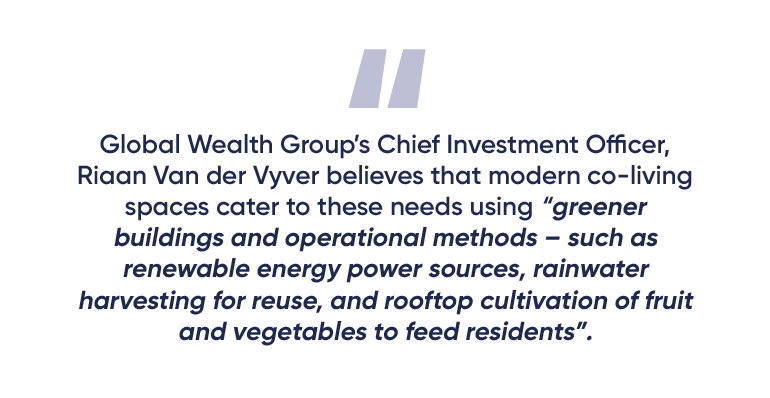
Gain the advantage of co-living’s predictable income as an investor
The growing appeal of co-living and its role in residential real estate
The way people live and work has been changing over the years, and purpose-built co-living is the evolution of communal residences – driven partly by housing shortages, the costs of house ownership, and inflation. For investors looking to diversify real estate investments, this multi-family asset class suits the needs of many people. It is in high demand, making it a popular choice for investors.
The idea of communal living isn’t new, as discussed in last week’s article when it comes to shared living residences there have been many options available over the years. One of the main differences between co-living and co-housing residences is the different areas that provide private and communal spaces. In this regard, it’s important to note that both co-housing and co-living fall under multi-family real estate, which is one property that can accommodate multiple family units. In comparison, a single-family property only caters to a single family, therefore, investors can benefit from the income of many tenants in a multi-family residence.
A definition of co-housing
In a co-housing situation, each person will have their own full residence but share areas such as the gardens, laundry, and spaces that allow for social gatherings or interactions. This is similar to living on a secure lifestyle estate, which generally has more luxurious amenities including top-notch security, great locations and scenery, with the addition of unique features for luxury apartments or homes. Coincidentally South Africa is recognised as a global pioneer in estate living and ranks highly on the list of the world’s best lifestyle estates.1
A definition of co-living
Co-living properties are based on the idea of fully furnished student housing, offering the privacy of a bedroom (for more upscale buildings, potentially including an en-suite bathroom) but with shared communal areas for bathrooms, dining, lounging, working or studying. In February 2020, a report from Savills described co-living as a global trend, with the expectation that it will have “sustained growth in an emerging property sector dominated by young professionals”.2
Co-living purpose-built housing meets a need for short-term and long-term renters wanting elegant finishes with well-thought-out communal living spaces, but for a more mature target market.3 Instead of supplying students with purpose-built housing, these demographics typically range from 25 to 34-year-olds. Co-living developments are suited to people between 20-44 years of age who desire greater flexibility in tenure as they tend to be more transient in employment and personal circumstances.4
The rising appeal of co-living worldwide
In the USA alone CBRE Research found that in 2019, about 150 co-living communities provided more than 5,000 beds.5 While that number seems small, this represents the substantial growth of this industry, bearing in mind that four years ago, co-living options worldwide were only available on a much smaller scale.6 People looking specifically for co-living residences can even find companies online that specialise in this niche area such as coliving.com, which offers residences for rent in Spain, France, and USA.
According to Investec, co-living in the UK is recognised by 56% of institutional investors to be a competitive market with the potential benefits of low but stable returns, and income from multiple tenants, especially as global bond yields increase yearly.7

Unsurprisingly China takes the top spot beating out India for its co-living industry, China alone accounts for 2.8 million people in these residences with a market size of $6.72 billion (USD).8 To put this into perspective Asia is in the co-living market, but south-east Asia has 500,000 tenants and India has 130,000 tenants compared to China’s sizeable market share.9
High density countries such as Australia are also recognising that this is becoming the “new normal” as a rental option. The Switch has recently opened a $70 million (AUD) 39-storey high-rise building in Perth’s CBD.10 Although the company isn’t the first to capitalise on this emerging sub-asset class, it implies a definite sign of changing times.
Wealth Migrate’s co-living investment and the reasons for offering it

Diversification is the best strategy you could implement within your investment portfolio to withstand market uncertainty. Through diversification, an investor can balance risk and reward while capitalising on beneficial opportunities. The popularity of the emerging co-living sub-asset class will increase as it meets a vital housing need in a market where single-family real estate is rapidly becoming unaffordable and is also inflexible for people that follow a more nomadic digital lifestyle.
As a result, co-living will become a greater necessity to keep up with the rising demand for housing. In our partnership with BNTO (Pty) Ltd (formerly known as Six C Pty Ltd), this was brought to light in a focused webinar on co-living assets; BNTO is a co-living development and operating company based in Australia. BNTO’s mission is to develop sustainable and secure purpose-built co-living (PBCL) communities in locations where attractive affordable living opportunities do not currently exist and are desired.11
The investment webinar focuses on Brisbane Co-living Apartments: Development Approval Phase (Institutional Equity Release), because co-living has taken off in Australia as the soaring housing prices have made homeownership challenging for those that don’t have a substantial nest egg to purchase a home. The 1,417m2 site will house 112 co-living units once completed.12 The site is being developed by BNTO, which was granted a development application (approved in June 2022), and assisted by Highgate Management Pty Ltd.
With co-living’s appeal in luxury communal accommodation and other benefits from location to convenience, businesses continue to invest heavily in co-living properties across Australia. The Brisbane Co-living Apartments is strategically situated just 400m from one of the largest hospital precincts in Brisbane. The Chermside neighbourhood is vibrant with plenty of foot traffic and retail activity, as it’s a mere 10-minute walk to one of the largest shopping centres in the south, ensuring plenty of foot traffic and retail activity.
Other nearby amenities include, medical (with The Prince Charles Hospital complex being a short 17-minute walk), a hotspot of recreation activities (from parks, to dining, and retail within two streets of the site), and a wide range of available bus routes (as the CBD is only 9km away). The residential buildings surrounding 46-50 Latham Street have good occupancy rates, with many tenants opting to walk or use nearby public transport.
Since wealth protection is a long-term strategy, an excellent way to mitigate risk is by future-proofing investments. There’s been a surge in the market for investments that offer sustainable solutions, by reducing the systemic risk of climate change and scarcity of natural resources such as land and water.13

This is where purpose-built co-living (PBCL) is emerging as a promising option to reduce the housing crisis, while minimising society’s impact on the environment. The demand for eco-friendly residential buildings is confirmed by the increasing popularity of sustainable investing. It’s a rising demand, more than a trend, with environmental, social, and governance (ESG) assets under management set to hit $53 trillion (USD) by 2025.14
The future of co-living housing
According to BNTO,15 PBCL is a low-risk investment asset class with the largest diverse range of tenants outside of self-storage facilities. Compared to self-storage tenant rates and occupancy, affordable residential rental units remain in high demand, which does not diminish. In countries like Australia, co-living properties benefit from higher depreciation, creating a higher return for investors than other property investments.
Co-living is here to stay – with purposeful intention, curated design, and technology, leading the way – to promote a sense of community and social awareness in a unique living space. The idea of what makes a home is growing into a movement for co-living; based on many factors such as urban density, housing prices, sustainability, convenience, affordability, and the flexibility of short- and long- term leases.
As part of an ongoing educational series, our next article will explore the global trends and successes of purposeful co-living.
Find more Wealth Migrate content here:
View our focused webinar on investing in co-living, where our team and deal sponsors analyse the strong demand for this asset class.
Read our investment articles and listen to the podcasts. We cover the topics of diversification, structured notes, and purpose-built-co-living, click here for the full list on Wealth Migrate archives – BizNews.
1 Property24. (July 2022). ‘The top lifestyle estates in South Africa for 2022’. Retrieved from Property24.
2 Newland, C., and Savitz, P. (February 2020). The global trend in co-living spaces’. Retrieved from Savills.
3 Newland, C., and Savitz, P. (February 2020). The global trend in co-living spaces’. Retrieved from Savills.
4 BNTO Coliving. (December 2021). ‘Co-living, the next unicorn?’. Retrieved from LinkedIn.
5 Rice, J., Entis, G., and Sabat, J., et al. (January 2020) ‘Innovation watch: the rise of co-living’. Retrieved from CBRE.
6 Rice, J., Entis, G., and Sabat, J., et al. (January 2020) ‘Innovation watch: the rise of co-living’. Retrieved from CBRE.
7 Investec. (June 2019). ‘The ‘Living’ concept in action: blended student and co-living’. Retrieved from Investec.
8 Kumar, A., and Hatti, C. (December 2019). ‘Global Coliving Report 2019: living, together’. Retrieved from Housemonk.
9 Kumar, A., and Hatti, C. (December 2019). ‘Global Coliving Report 2019: living, together’. Retrieved from Housemonk.
10 Brookes, Sarah. (March 2022). ‘Millennials flocks to nations first ‘co-living skyscraper’ from The Switch’. Retrieved from The Sydney Morning Herald.
11 BNTO Coliving. (December 2021). ‘Co-living, the next unicorn?’. Retrieved from LinkedIn.
12 Wealth Migrate. (March 2022). ‘Property 5.0: what is co-living and why there is strong demand for this asset class?’. Retrieved from YouTube.
13 Brish, M. (March 2022). ‘Opinion: how to future-proof your stock investments and outperform the market at the same time’. Retrieved from MarketWatch.
14 Diab, A., and Martin Adams, G. (February 2021). ‘ESG assets may hit $53 trillion by 2025, a third of global AUM’. Retrieved from Bloomberg.
15 BNTO Coliving. (December 2021). ‘Co-living, the next unicorn?’. Retrieved from LinkedIn.